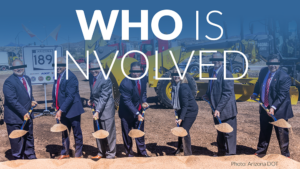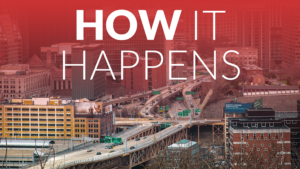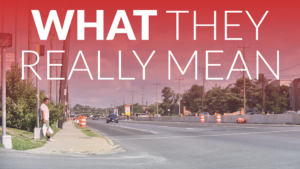Related Resources
Community Connectors Portal: Tools for advocates > Who is involvedAdvocacy lifecycle
Advocacy 101: The advocacy lifecycle
Building a simple agenda around some core principles will serve as the foundation for your advocacy, enabling you to orient your resources toward achievable goals aligned with your values. Over the course of your advocacy, you’ll need to cultivate productive relationships with elected officials and learn how to lobby them, build coalitions of support, and communicate to win. And win or lose, you’ll have to consider how to evaluate success or failure and chart new courses of action.
Setting key priorities
Time and resources are always limited. For that reason, advocates should select priorities that allow them to meet both their short-term and overarching goals. When selecting priorities, consider your organization’s place in your local context and leverage that position with electeds and stakeholders. Resist the urge to make your platform too big by adopting everyone’s issue that joins your coalition. (A mistake that T4America made early on. Instead of 10 principles or goals, we only have three, which allows us to focus our work and let other organizations lead on important issues that we care about, but aren’t core to our platform.)
While it’s easy to come up with long lists of what’s wrong with transportation, it’s more important to translate issues into an agenda for specific actions that will result in measurable changes and reforms. Make sure your goals are directed toward policy changes that can realistically and measurably result in improvements. Instead of chasing opportunities that align with abstract values, such as “Make it easier to bike”, consider pursuing concrete goals. For example: in their 20×20 campaign, advocates with the Washington Area Bicyclist Association pushed the District of Columbia’s DOT to add 20 new miles of protected bike lanes by 2020’s end, ten times any amount the city DOT had added in a year before. Although they were not able to get all 20 miles, their efforts built relationships with councilmembers and the campaign’s clear vision kept the pressure on the city to keep developing projects that serve their values.
Things to consider
All change begins within the realities of your built and political environment. Given the time, money, and relationships you have, what avenues for change can you identify and mobilize around? Start with questions like these:
Who…
- Are the champions for your cause?
- Are the core members of your coalition?
- Can join your coalition?
- Is open to your message?
- Do you have relationships with, and who do they have relationships with?
- Is in the legislative or executive body you need to do work with?
- Controls the infrastructure? State DOT, the city, or someone else?
- Controls project funding?
What…
- Is a realistic change to expect from each stakeholder?
- Policy measure would best address your community’s issues?
- Could you do to educate elected officials or even DOT stakeholders?
- Projects can you intervene in? (Don’t waste valuable time on projects that are too late to fight over.)
- What recent victories or current failures can you use to raise your agenda and make it relevant?
When…
- Are there openings for change in the future?
- Is the next election?
- Is the next transit or land-use plan update?
- Is your council or legislative body in session?
How…
- Will you engage with your current resources? Direct lobbying, ad campaigns, public outreach, or public education?
- Do you think change happens in your community and how have you seen it work in the past?
- Will you craft and frame your message to each audience?
- Will you bring along some percentage of people currently satisfied with the status quo?
Perfection: The enemy of the good
It can be hard to accept, but compromises will be frequent and necessary. Above all, don’t let a potential win go by because it does not perfectly align with all of your policy goals. It’s nearly impossible to win while being a purist. Incremental progress is better than no progress, and every victory builds momentum. These small wins will give you room to be more ambitious toward your larger goals.
Consider the case of transit advocates in Indianapolis in the 2010s. Through broad coalition building between activists, faith groups, and business interests, advocates for transit were able to first win state legislation that enabled them to raise local taxes to fund transit and advance their plans for investing in improved bus service and building a bus rapid transit network. This win was far from perfect, as it came with a poison pill provision banning them from using any funds on light rail, but advocates took the win and pressed ahead with their plans and left the battle over rail for another day. The state legislation allowed them to advance a successful ballot measure which allowed the city to build and launch the Red Line bus rapid transit route, with the new Purple Line BRT under construction, and a third line, the Blue Line planned next. None of which would have happened if they’d held the purist line on light rail and refused to support the legislation that enabled it all.
What happens when you start winning?
Even the wins require more work. Complete Streets policies are a great example: Passing the policy is just one of the very first steps—putting that policy into practice arguably takes far more work and effort, both from the transportation agency staff and leaders and from the local coalition of advocates. The implications of the policies you advocated for are sometimes not fully apparent until after they’re implemented, and advocating for tweaks to implementation can ensure policies work as intended, preventing backlash.
And if you did win?
Every win should be a springboard for a deeper transformation in your community to a system that centers people first. After each win, ask yourselves some questions:
- What have we accomplished?
- What should be next?
- Should our initial goals grow?
- Is it time to expand our agenda?
- Could we extend our agenda to influence new geographies?
- Could our coalition broaden its base and develop new allies?
- Are more ambitious goals possible now?
- Are there groups, particularly from underrepresented or underserved populations, that have been left out of our advocacy coalition until now?
- How do we tell and elevate our story to inspire other like-minded advocates in other communities?






